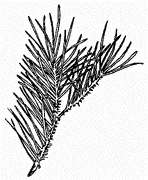 Sawflies are a large and diverse group of insects that defoliate hardwood and coniferous trees in the United States. Several species are native to Texas, but the one that causes the most concern is the redheaded pine sawfly, Neodiprion lecontei (Fitch). This species is an important defoliator of young southern yellow pines (less than 15-20 feet tall). Sawflies are not true flies. Rather they are wasps (Hymenoptera), but they cannot sting. They get their name from the saw-like structure on the end of the female’s abdomen. She uses this structure (called an ovipositor) to lay eggs in small slits she cuts with it in the pine needles. The adult or wasp stage of the sawfly is seldom seen and only causes minimal damage to plants when the female deposits her eggs. It is the larval stage that consumes the needles and causes damage.
Sawflies are a large and diverse group of insects that defoliate hardwood and coniferous trees in the United States. Several species are native to Texas, but the one that causes the most concern is the redheaded pine sawfly, Neodiprion lecontei (Fitch). This species is an important defoliator of young southern yellow pines (less than 15-20 feet tall). Sawflies are not true flies. Rather they are wasps (Hymenoptera), but they cannot sting. They get their name from the saw-like structure on the end of the female’s abdomen. She uses this structure (called an ovipositor) to lay eggs in small slits she cuts with it in the pine needles. The adult or wasp stage of the sawfly is seldom seen and only causes minimal damage to plants when the female deposits her eggs. It is the larval stage that consumes the needles and causes damage.
Sawfly larvae don’t have the typical grub-like appearance of most wasp larvae. Superficially, they resemble a moth or butterfly (Lepidoptera) caterpillar. The easiest way to distinguish sawfly larvae is by their more than five pairs of fleshy legs on the abdomen and only one eye on each side of the head. Moth and butterfly larvae have five or less fleshy legs and six eyes on each side of the head. The redheaded pine sawfly is particularly damaging to young pine plantations. They are occasionally a problem to ornamental trees. This sawfly has caused increased concern in recent years, possibly due to the establishment of more pine plantations. Sawfly outbreaks in young plantations sometimes spread over large areas and may persist for several years.
Redheaded pine sawflies overwinter in a dormant larval stage changing to pupae in early spring with adults emerging a few weeks later. Some individuals remain in the dormant larval stage until the second spring before they pupate and emerge as adults. This allows some sawflies to survive if most of the current generation die. Females deposit 100 or more eggs in rows of slits they saw in the edges of needles. Usually one egg is laid in each slit. The female produces living eggs even though she may not have mated with a male sawfly. Fertilized eggs produce both male and female offspring, but the unfertilized eggs produce only females.
The larvae emerge from the eggs in 15-30 days and begin to feed in groups on the pine needles. They usually feed on a tree from top to bottom, completely defoliating one branch before moving to another. They may even feed on the tender bark of young twigs. Small trees that are completely defoliated seldom live. The amount of time required for the larvae to develop depends on the air temperature - the cooler it is the longer the time to develop. When weather conditions are favorable, as many as five generations may be produced in one year.
Full-grown larvae are about an inch long (22-25mm). They have a rust-red head and a hairless, yellowish-white body with six rows of black dots. If sawfly larvae are disturbed they have the characteristic habit of curling the forward third of their body backward, presumably as a defensive measure to scare enemies. When the larvae are mature, they drop to the ground and spin a tough, egg-shaped tan to reddish-brown cocoon in the soil or litter where they spend the winter. There are several important natural control factors which affect the redheaded pine sawfly.
Populations may decline rapidly due to adverse weather (especially in the early spring), parasites, predators, a virus disease, and rodents that feed on pupae. Several cultural controls for sawflies in pine plantations have been suggested. Apparently sawflies prefer some shade; therefore, the most important of these is to keep the plantations as free of overshadowing hardwoods as possible. When chemical control of sawflies is warranted, Orthene or Sevin can be used. Sprays should be applied to the foliage as soon as an infestation is observed. Since several generations may occur in a year, suspected areas should be checked throughout the summer for possible infestations.
All suggested chemicals must be registered for use on sawflies by the US Environmental Protection Agency and the Texas Department of Agriculture. Before using any pesticide, read and carefully follow all application directions, cautionary statements, and other information on the label.
Typical Redheaded Pine Sawfly Larvae.
(click photo for full size)
